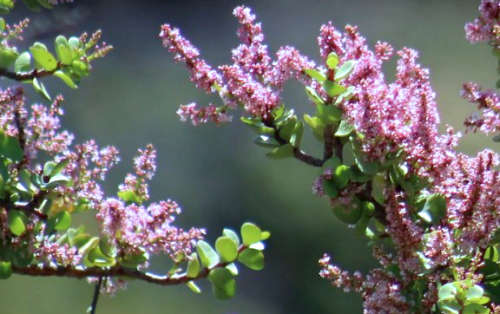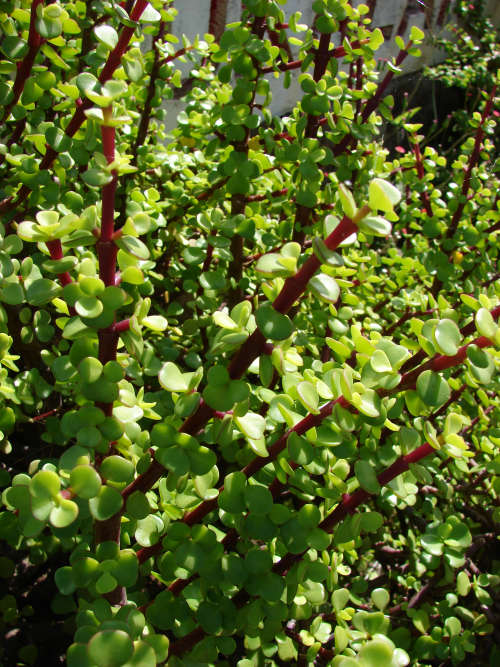Growing Portulacaria afra:
Elephant Bush
Description
Form: A succulent shrub.
Lifespan: Over 50 years.
Leaf retention: Evergreen.
Growth rate: Slow to rapid depending on growing conditions.
Mature Size: 4-12' (1.2-3.7m) high and somewhat wider.
Flowers: Tiny, white to pink to lavender, clustered on terminal spikes.
Bloom: Late spring to early summer. Watering, moist soil, and enriched or fertilized soil discourage blooming.
Fruit: Small dry capsule.
Leaves: Green, oval, smooth margins, fleshy and edible. They regrow quickly after being browsed. Several cultivars have variegated leaves.
Stems: Green to dark red, easily broken. Broken branches fallen on the ground may take root.
Roots: Extensive.
Wildlife: The flowers, if any, attract bees. The foliage attract browsing animals, including elephants, cattle, javelina, rabbits and desert rats. It is a favorite of tortoises.
Toxic / Danger: No.
Origin: South Africa.
Form: A succulent shrub.
Lifespan: Over 50 years.
Leaf retention: Evergreen.
Growth rate: Slow to rapid depending on growing conditions.
Mature Size: 4-12' (1.2-3.7m) high and somewhat wider.
Flowers: Tiny, white to pink to lavender, clustered on terminal spikes.
Bloom: Late spring to early summer. Watering, moist soil, and enriched or fertilized soil discourage blooming.
Fruit: Small dry capsule.
Leaves: Green, oval, smooth margins, fleshy and edible. They regrow quickly after being browsed. Several cultivars have variegated leaves.
Stems: Green to dark red, easily broken. Broken branches fallen on the ground may take root.
Roots: Extensive.
Wildlife: The flowers, if any, attract bees. The foliage attract browsing animals, including elephants, cattle, javelina, rabbits and desert rats. It is a favorite of tortoises.
Toxic / Danger: No.
Origin: South Africa.
Cultivation and Uses
USDA hardiness zones: 9b-11. This plant is root hardy to 25°F (-3.9°C) after becoming established. It will die to the ground at 30°F (-1.1°C).
Heat tolerant: Yes, however, green varieties tolerate high temperatures better than variegated varieties.
Drought tolerant: Yes.
Sun: Part shade all day or morning sun with afternoon part shade. In high temperatures, avoid afternoon full sun. This plant tends to grow lanky with too much shade. It does not tolerate full shade.
Soil: Well draining, dry, low in organic content, sandy. Portulacaria afra plant is somewhat tolerant of soil types otherwise. It is salt tolerant. Fertilizing or enriched soil will prevent this plant from flowering. If it is growing too slowly in an indoor pot, however, 1/4 tsp (1ml) of plant fertilizer, even tomato fertilizer, sprinkled on the soil, and watered in with a small amount of water, once a year, will cause it to become darker green and faster growing, although without flowers.
Water after becoming established: Once a month, accommodating for rain. This plant needs little to no water in a favorable location.
Mulch: Mulch only in freezing conditions during the first three years. Remove mulch quickly after the last freeze so the soil will dry faster. Moist soil inhibits blooming.
First Year Care: Protect from freezing the first two or three years. Deep watering in the first year will help the plant develop deep roots to withstand heat and drought.
Planting: Outdoors, this plant handles high temperatures much better in the ground, but can be grown in containers with more frequent watering. It must be protected from browsing animals.
It can be grown indoors in a sunny location, and can be used for bonsai.
Prune: Trimming is well tolerated and can be done to shape.
Litter: Low.
Propagation: Cuttings root easily.
Uses: Ornamental, erosion control, culinary. The edible leaves are high in vitamin C, have a cucumber-citrus or green apple flavor, and can be added to salads and soups.
USDA hardiness zones: 9b-11. This plant is root hardy to 25°F (-3.9°C) after becoming established. It will die to the ground at 30°F (-1.1°C).
Heat tolerant: Yes, however, green varieties tolerate high temperatures better than variegated varieties.
Drought tolerant: Yes.
Sun: Part shade all day or morning sun with afternoon part shade. In high temperatures, avoid afternoon full sun. This plant tends to grow lanky with too much shade. It does not tolerate full shade.
Soil: Well draining, dry, low in organic content, sandy. Portulacaria afra plant is somewhat tolerant of soil types otherwise. It is salt tolerant. Fertilizing or enriched soil will prevent this plant from flowering. If it is growing too slowly in an indoor pot, however, 1/4 tsp (1ml) of plant fertilizer, even tomato fertilizer, sprinkled on the soil, and watered in with a small amount of water, once a year, will cause it to become darker green and faster growing, although without flowers.
Water after becoming established: Once a month, accommodating for rain. This plant needs little to no water in a favorable location.
Mulch: Mulch only in freezing conditions during the first three years. Remove mulch quickly after the last freeze so the soil will dry faster. Moist soil inhibits blooming.
First Year Care: Protect from freezing the first two or three years. Deep watering in the first year will help the plant develop deep roots to withstand heat and drought.
Planting: Outdoors, this plant handles high temperatures much better in the ground, but can be grown in containers with more frequent watering. It must be protected from browsing animals.
It can be grown indoors in a sunny location, and can be used for bonsai.
Prune: Trimming is well tolerated and can be done to shape.
Litter: Low.
Propagation: Cuttings root easily.
Uses: Ornamental, erosion control, culinary. The edible leaves are high in vitamin C, have a cucumber-citrus or green apple flavor, and can be added to salads and soups.
Comments
This plant is a member of the Porkbush family (Didiereaceae). It was previously assigned to the Purslane family. Other common names are Elephant Food and Pork Bush.
Portulacaria afra has the distinction of being a high carbon-sink plant, removing more carbon dioxide from the air during photosynthesis than most other plants.
It often does not flower in cultivation because it should not be grown in enriched soil, or fertilized, and the soil must be entirely dry before it is scheduled to bloom.
Do you have additional information or a different experience for these plants that you would like to share? Email info@GardenOracle.com. All contributions are welcome and appreciated.
This plant is a member of the Porkbush family (Didiereaceae). It was previously assigned to the Purslane family. Other common names are Elephant Food and Pork Bush.
Portulacaria afra has the distinction of being a high carbon-sink plant, removing more carbon dioxide from the air during photosynthesis than most other plants.
It often does not flower in cultivation because it should not be grown in enriched soil, or fertilized, and the soil must be entirely dry before it is scheduled to bloom.
Do you have additional information or a different experience for these plants that you would like to share? Email info@GardenOracle.com. All contributions are welcome and appreciated.


Latest update: May, 2025
© 2008-2025 by GardenOracle.com

